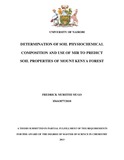| dc.description.abstract | The aim of this study is to use alternative methods that are being developed to enhance or replace conventional methods of soil analysis, as they overcome some of their limitations. To obtain an overview of the physical and chemical properties of soils in Mt. Kenya forest, 308 samples were collected from top-soils (0-20cm) and sub-soils (20-50cm). All the samples were analyzed using MIR. A reference sample set of 32 samples selected from these 308 samples were analyzed for; total elements using Total X-Ray Fluorescence, total organic carbon (TOC) and nitrogen (TN) using a CN analyzer, Particle size distribution using LASER method and clay mineralogy using
XRD.
It was observed that the soils were acidic with average pH values of 4.72 for tops soil and 4.91 for sub soil. The average total organic carbon was 11.27% for top-soil and 6.34% for sub-soil while total nitrogen was 0.95% for top-soils and 0.53% for sub-soils. These values are within the acceptable ranges for forest soils indicating the soils are good for forest vegetation growth and regeneration.
The average concentrations of soil elements was found to be; AI, 55.80; P, 0.67; S, 0.93; CI, 0.18; K, 7.25, Ca, 2.36; Ti, 3.87; Cr, 0.06; Mn, l.82; Fe, 52.80; Co, 0.16; Ni and Cu 0.01 and Zn, 0.l1 gKg-1 top-soils (0-20cm). The average concentrations of AI, 67.80; P, 0.49; S, 0.60; Cl, 0.18; K, 6.50; Ca, 0.91; Ti, 4.01; Cr, 0.06; Mn, l.78; Fe, 57.7; Co, 0.17; Ni and Cu 0.01 and Zn, 0.12 gKg-1 for sub-soils (20-50cm). Most of the concentrations are within the recommended concentrations for soils except for aluminium and iron which are on the higher side but not very toxic concentrations.
The soil minerals were Albite, Microcline, Montmorillonite, Gibbsite and Nacrite. These soils were observed to contain clay at the range of 7.62% - 93.2% in calgon and 8.1% - 56.8% in water; sand at the range of2.51% - 83.8% in calgon and 27.2% -73.6% in water, and silt at the range of 6.34% - 46.7% in calgon and 12.7% - 39.6% in water. The particle size distributions were similar to what is reported in literature for most forest soils. The main soils minerals indicate that the minerals playa critical role in the chemical processes of the forest soils by contributing in the soil cations pool.
The coefficient of determination (R2) obtained from calibration models for TOC, TN, K, AI, S, Fe, Co and Ti were 0.94, 0.88, 0.98, 0.91, 0.89, 0.86, 0.82 and 0.80 respectively. The R2 for Ca, CI and pH were 0.75, 0.75 and 0.73 respectively. Ni, Cu and Zn had lower values of 0.65, 0.63 and 0.61 respectively while Cr, Mn and P had values of 0.47, 0.43 and 0.27. The high R2 (0.98::; R2 ~0.80) values obtained indicates that the calibration models are robust and can be used to satisfactorily predict the given soil properties. In addition, for the medium R2 (0.75:::;R2 ~0.60)
can be improved to within the satisfactory levels. | en |

